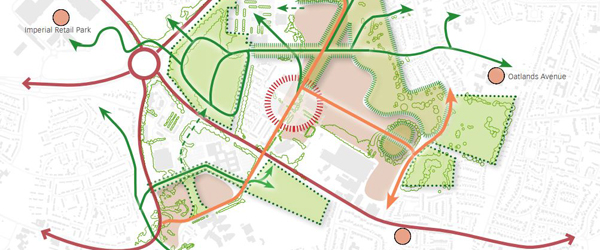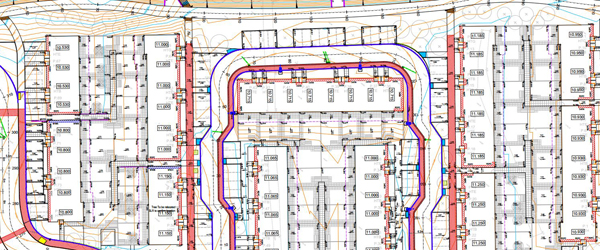
Transport Development Management (TDM) plays a vital role in the planning process by fulfilling the highway authority's statutory duty to respond to planning proposals that will:
- have an impact on existing movement networks and infrastructure
- involve the construction of new movement infrastructure
- require the enhancement of existing movement infrastructure
Early liaison between applicants and TDM is essential, particularly on larger schemes, to provide developers, landowners and the council's Property, Housing Delivery and Regeneration teams with certainty on the objectives and opportunities presented by each development. We'll take into consideration:
- adjoining sites
- local issues
- strategic objectives
This avoids missing opportunities and makes sure there is a coordinated approach to land-use planning that will deliver connectivity and improved health outcomes across the city.
On occasion, particularly for major sites, we may insist that developers consult with us informally before submitting a pre-application enquiry where we know there are major constraints or strategic objectives which need to be considered before any design work. In each of these cases we'll request and orchestrate this dialogue through the planning case officer so these matters can be highlighted and understood.
To the right of this page you'll find detailed information (sections 2.1.1 to 2.1.8) on our expectations of the pre-application process, including:
- the importance of good masterplanning
- our requirements for scoping and assessment
- the necessity of highway improvements and the recommendations we make
The accompanying Transport for New Homes checklist and parking survey appendices are also relevant to this stage of the process.
TDM represents a broad remit of highways and transport interests. As a result we must consult a range of specialist officers and engineers outside of TDM to provide a holistic and consistent response to pre-application enquiries.
We prefer to do this at the pre-application stage to give greater and more timely certainty to your planning applications.
A summary of the key internal consultees whose concerns we represent is provided below and whose views we obtain through the Planning Application Management (PAM) process.
City Transport
- Transport Policy, Strategy and Bidding; Major Transport Projects
- Public Transport Infrastructure
- Area Traffic Engineering and Road Safety, Walking and Cycling
- Traffic Regulation Orders
- Travel Planning, Special Projects and Engagement
- Flood Risk, Data and Intelligence
Traffic and Highways
- Highway Maintenance and Asset Management
- Bridges and Structures
- Street Lighting
- Network Management
- Traffic Signals and Urban Traffic Control
- Public Rights of Way
- Parking Services and Enforcement
- Operations Centre and BNET/Connect City Telecommunications Infrastructure
Once we have provided our pre-application comments, planning officers must then balance these recommendations with the views of other specialist disciplines including:
- architecture and urban design
- placemaking
- heritage, conservation and archaeology
- ecology, arboriculture and landscape design
One of the most important internal consultees we must liaise and reach agreement with is the City Design Group (CDG) whose remit spans across each of the above disciplines.
Given the inter-relationships between placemaking, movement and connectivity, it's crucial that an applicant receives a joined-up response from the planning case officer that seeks to combine the recommendations of TDM and CDG in the interests of consistency.
Similar to the planning application process, it's for this reason that we're unlikely to respond directly to applicants or their consultants in isolation from the views of our colleagues on a pre-application enquiry, unless this has been expressly agreed by the planning case officer in advance.
This is why we require pre-application enquiries to be made in sufficient time before a planning application, so we can effectively aid both the developer and the council in achieving efficiency when a formal proposal is submitted for planning consent.

Our role is to critically assess planning proposals from a spatial perspective. The following are of principle concern:
- safety - resisting harmful impacts
- health - supporting and promoting active and sustainable modes of travel
- delivery - overseeing the provision of safe and maintainable infrastructure
We'll resist development proposals that fail to fulfil each of the above considerations.
The Transport Development Management Guide (TDMG) Section 2.2 concentrates on the process of determining a planning application, the recommendations made by TDM, and the necessity of conditions and obligations.
This is because we require applicants to have already considered and discussed their proposals and the transport implications of these with us at the pre-application stage. This allows for an agreed form of assessment and an emerging transport package to be discussed and formulated before a formal (and public) planning submission.
It is likely we will reject the findings of an application or accompanying assessment that is submitted independently of our prior input.
For further detailed information on our application processes, including commenting on applications, developer negotiation, securing conditions and agreeing obligations, refer to pdf 2.1.1 Planning Application stage(385 KB) process, found to the right of this page.

Transport Development Management (TDM) works with developers, consultants, architects and engineers during all stages of development, from concept through the pre-application and planning process to construction and certification.
To make this effective our team includes town planners, transport planners and highway engineers, each of whom bring specialist expertise at each stage to ensure that development works are safe, accessible and constructed correctly.
These planning and engineering functions were brought together to deliver a consistent service.
Process
TDM fulfils the council's responsibility as technical approval and inspection authority for all developer-delivered works to new and existing highway.
To protect the public purse from future safety and maintenance liability, we insist that all works undertaken by developers are done so in accordance with the following process. These incorporate our design requirements and standard details, as confirmed in the Transport Development Management Guide(TDMG) Section 3 and covered by a legal agreement pursuant to the Highways Act 1980, most commonly referred to as section 278 agreements (for works to existing highway) and section 38 agreements (for the creation of new highway).
These processes have seven stages:
- Planning Condition Discharge
- Legal Process and Payment of Bond and Fees
- Technical Approval
- Construction and Inspection
- Partial Completion (section 38 agreements)
- Substantial Completion and Maintenance Period
- Final certification and adoption
This process ensures the timely and satisfactory delivery of highway works that conform with our minimum requirements for safety, adoption and maintenance.
You will find more information about our section 278 and section 38 processes within parts 2.3.2 and 2.3.3 of the TDMG, accessible to the right of this page. Of particular importance are the pdf Highway Design Checklist(158 KB) and the document Section 278 application form(611 KB) , which we require developers, engineers to become familiar with.
Central to this is obtaining design technical approval from TDM and the approval of works on site following inspection.
A bond or surety must be secured for all new highway works, along with the payment of our technical approval, supervision and inspection fees.
Developers needing road or footpath closures, on-street scaffolding or skips, parking bay suspensions, or other traffic management measures will need to apply for the relevant highway licences and any temporary traffic regulation orders (TTRO) to manage works on streets, before commencing work. This will normally be outlined in a condition on any approved planning application.
Developers are normally needed need to submit a Construction Management Plan (CMP) or Statement that is consistent with the pdf standard CMP template(127 KB) for developments which are:
- larger, or going to take a long time to complete
- on or near major roads
- in very tightly constrained streets, or
- involving significant engineering works or road closures
Why we do this
We have an obligation to protect the public through ensuring works to our existing and future assets are carried out safely and under our supervision.
Failure to follow these processes has in the past led to unapproved and therefore deficient highway excavations and works, which in the short-term have delayed development and in the medium-long term have resulted in the following problems, not all of which are immediately visible.
- Safety hazards - leading to personal injuries, collisions and damage to vehicles
- Geometry - inadequate widths resulting in damage to footways and landscaping
- Carriageway defects - uneven or incorrectly laid / mixed surfaces
- Incorrect materials - resulting in structural failures reducing the lifespan of the asset
- Drainage issues - resulting in pooling, flooding and water damage
- Signage and lining - missing signs or road markings resulting in confusion or illegibility
- Obstructions - poorly placed street furniture and blockages to visibility and movement
- Lighting - incorrect specification or positioning leading to dark spots
- Parking - poorly located or sized parking leading to footway damage / visibility issues
- Gradient - inaccessible environments or risk of vehicle skidding in freezing conditions
- Structures - undermined highway stability resulting from unapproved excavation works
In each case, and depending upon when these matters are picked up, the above situations can result in considerable additional costs to both the developer as well as the council. This can result in the need for removal and reconstruction of works, or through future liability to the public purse.
We will raise any of these issues as soon as we are aware of them, whether this is at concept / pre-application stage, during the course of an application or at the post-permission stage. This is reliant on the quality and detail of the information, designs and supporting information we receive.
No time is too early to raise these matters. The greater the level of detail provided early on in the process, the greater the chance you have of benefiting from a swift approval, inspection and certification process, and, most importantly, the completion of safe and reliable infrastructure to serve the occupiers of your development.
At the pre-application stage we strongly advise you to refer to pdf TDMG section 2.1.4(2.19 MB) and the section headed Existing Site Constraints section so that any challenging issues are addressed head-on and in so doing avoiding future pitfalls which add time and cost to a project.
We will not agree or certify engineering works which would either fail to meet our construction standards, result in a safety problem or generate a future maintenance liability to the council.
Process documents
